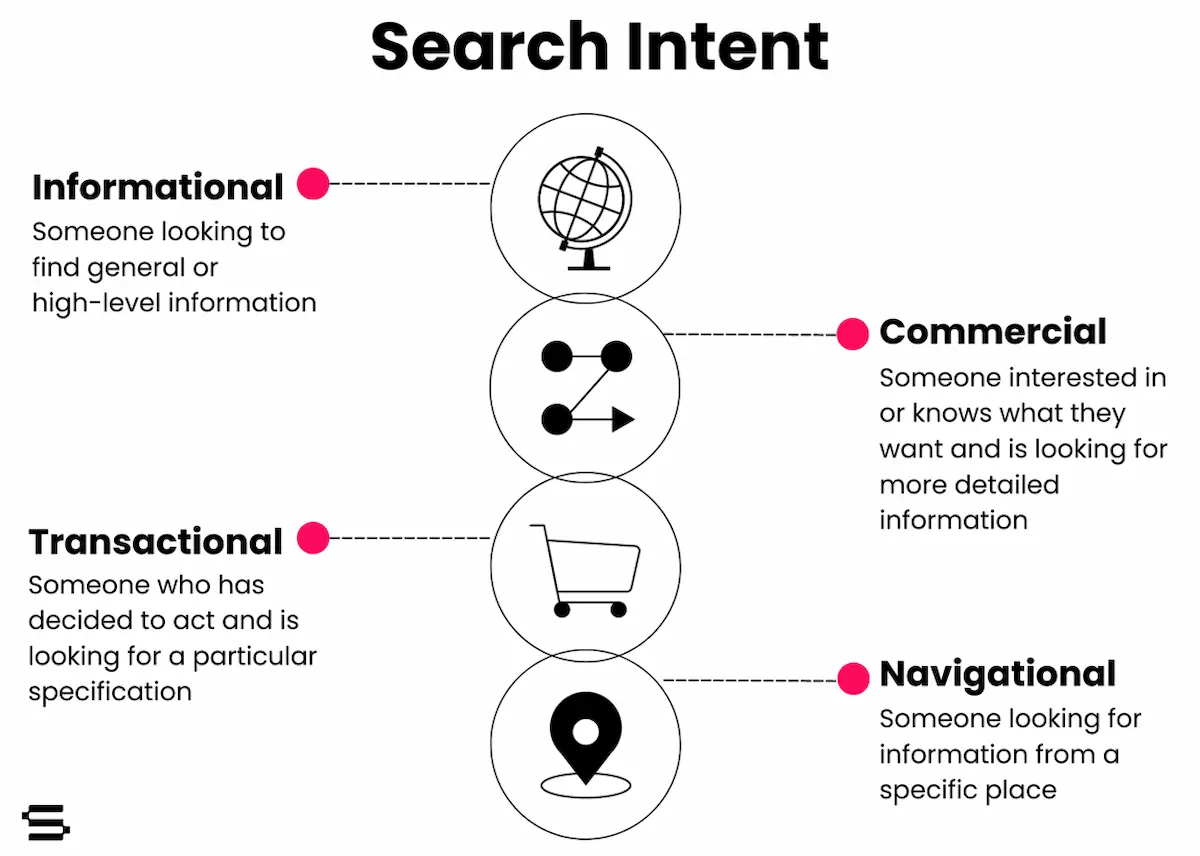SEO has come a long way since the days of inserting tons of keywords and crosslinks into site content. User experience has become increasingly important for a strong SEO strategy, even with the ever-evolving search landscape and rise of ChatGPT. With so much overlap, why are SEO and UX teams still so siloed?
This article walks through three key areas of overlap where UX and SEO knowledge sharing can lead to better collaboration and even better digital experiences for our users.
UX & SEO: Finding Value In the Overlap
To start breaking down the silos, we need to first understand where the overlap happens. According to my SEO colleagues, “the most important part of any SEO strategy is ensuring that your site content can be easily understood by both search engines and people alike.” As a UX designer, I focus on ensuring the experience is designed to be positive and as frictionless for users as possible.
At the end of the day, our goals are not mutually exclusive. Both teams strive to create digital experiences that users can find easily *and* find valuable.
Our Individual Approaches Are Really Not That Different
Responsibilities on the SEO side typically include things like benchmarking, keyword research, and audience research like user interviews, social media mining, and competitive analyses. SEOs use their research to better understand the person behind the search and the user’s search intent to inform a content and optimization strategy. Analytics and measurement can help determine success and inform future optimizations.
On the UX side, designers go through a similar process, starting with goal setting before moving into a research and discovery phase. Similar to SEO’s audience tactics, UX research can include things like user interviews, social media mining, and competitive analyses. UX designers use audience research methods to better understand user needs and inform a content and structural strategy for wireframing and design. Analytics, measurement, and additional user testing can help determine success and inform future optimizations.
There’s Magic In That Overlap
When you merge UX and SEO, there are a few intersection points where the individual approaches to digital overlap quite a bit. Knowledge sharing and collaboration during these intersection points can be the key to better understanding users’ needs and ultimately creating better and more targeted digital experiences.
Intersection Point #1: Research & Discovery
The first key area of overlap is research and discovery. Coming up with a research plan that leverages the strengths of both SEOs and UX designers can facilitate deeper and more connected insights, and also help diversify perspectives.
At this intersection, look to audience research, user interviews, keyword research, and competitor research. Each team can bring different things to the table to create a shared understanding of user needs.
Tips for a More Collaborative Discovery Process
Bake in periods for knowledge sharing and internal reviews at every major milestone in the discovery phase to help facilitate collaboration:
-
Agree on goals and objectives from all stakeholders: It’s important to make sure all teams are looped in from the very beginning while you’re benchmarking and setting goals. This can (and probably should) include folks outside of just SEO and UX, so think about your content writers, developers, and any additional project stakeholders or decision-makers. While getting all of those people aligned at the beginning can increase the time it takes to get started, it can mitigate a ton of future challenges that often happen with siloed teams.
-
Divide and conquer a research plan: The discovery phase is where the majority of the research happens, so it’s important to establish a cohesive research plan to avoid duplicating efforts. What qualitative and quantitative findings can each team bring to the table? Are there timeline contingencies to consider? What’s critical for success? Establishing a collaborative research plan early on can help the discovery phase be as efficient and effective as possible.
-
Schedule some facetime to review findings: Get a formal working session on the books to share qualitative and quantitative data findings together. Break out high-level themes, but also provide teammates with any raw data in case they want to dig in more themselves. Thought tools like Empathy Mapping can help distill the research and data into an organized structure that maps out the tasks, feelings, influences, and pain points a user may be feeling while trying to achieve their goal. Not only does this shared understanding help support and inform design and content decisions, but it can also help prime stakeholders for decision-making and approvals down the road. Each team has a unique perspective, so this is where that magic can happen to discover deeper insights and connections.
Intersection Point #2: Content Strategy
The second area of intersection is with the content strategy. Collaboration during content planning and creation helps UX and SEO teams more effectively connect the dots between the research and how the digital experience will take shape.
Where the content lives within the overall experience and how the content is structured are important for successful SEO and UX strategies. Thinking holistically about these aspects of the content strategy can help ensure neither SEO or UX is treated like an afterthought.
Creating a More Holistic Content Strategy
-
Consider the user’s search intent and unique needs: Collaboration during content planning and creation can help ensure the experience meets users’ needs and makes sense. What can keyword research and the SERPs tell us about the type of content and assets users are looking for? What does our audience research tell us about user motivations and pain points? Where should this content live? Aligning on the content strategy from both a UX and SEO perspective can ensure the content answers the questions users are searching for, flows logically, and fits cohesively within the overall experience. Things like optimized headings, internal linking, and structure and hierarchy should all be considered within a holistic strategy.
-
Stress test with wireframes: An SEO-optimized content model can help define what content is most helpful to users, but wireframing takes that one step further and defines how that content takes shape. What page structure most effectively communicates the content to users in a way that’s frictionless and easy to understand? What’s the optimal word count and level of detail needed to provide a comprehensive experience? What features or functionality can help improve the experience? We often think of wireframing as the stage where we can validate content and UX with usability testing. In a more collaborative approach, it’s also a great place to get feedback from SEOs on any structural or technical concerns that might compromise search value before fully investing in design and development.
-
Continue to talk to each other: We’ve all felt the pain of siloed teams. Ever try to shoehorn an SEO strategy into approved designs during the implementation process? Or maybe you’re on UX cleanup duty for content that’s become far too unruly and disjointed to ignore. Either way you slice it, silos lead to breakdowns , churn, and inefficiencies. The communication between SEO and UX should not be an “FYI!”. Both teams are critical to reconciling stakeholder feedback and learnings as the content strategy takes shape. Keeping communication lines open and active during content planning and creation can make sure the end product balances both UX and SEO needs, which will ultimately provide a better experience for our users.
Intersection Point #3: General Usability
And finally, the third area is plain old-fashioned usability. As the project progresses through the design and implementation phases, the ownership often shifts to the design team. However, it’s important to keep SEO teammates looped in as content and designs are reviewed by stakeholders and inevitably revised.
Conduct a Simple Usability Audit
This simple checklist can help maximize search value and provide a positive user experience:
-
Headings are SEO-optimized and scannable
-
Alt-text is used for all images
-
Images do not convey any net new concepts not mentioned in the content
-
Page or asset is mobile-responsive and optimized for different devices
-
Structural content shifts are minimized
-
Intrusive interstitials are avoided
-
Content answers users’ questions comprehensively
-
Site follows safe browsing best practices with HTTPS
-
Page speed is optimized
-
Image sizes are reduced and style sheets are consolidated
-
Proper tracking is installed and the page or asset is measurable
-
Both UX designers and SEO practitioners have QA tested
Remember, We’re All In It Together
Transitioning from siloed teams to a more collaborative, holistic digital marketing approach takes some getting used to. Both sides will have growing pains as new processes are defined and figured out. A huge part of the challenge is opening up those lines of communication between teams, so be patient with each other. I’ve learned a lot about SEO from my colleagues at Seer over the years and can’t imagine UX design without their search insights. That said, the collaborative process can always be refined, especially as the landscape evolves and efficiencies (or even roadblocks) happen.
Ultimately, when we look at those intersection points, we find that we’re really all working towards the same goal to make the web better for everyone. Interested in learning more about the value of UX and SEO collaboration? Let's talk!
Want more posts like this? Subscribe to the Seer Newsletter:



